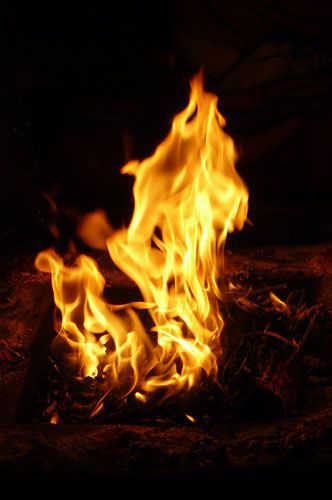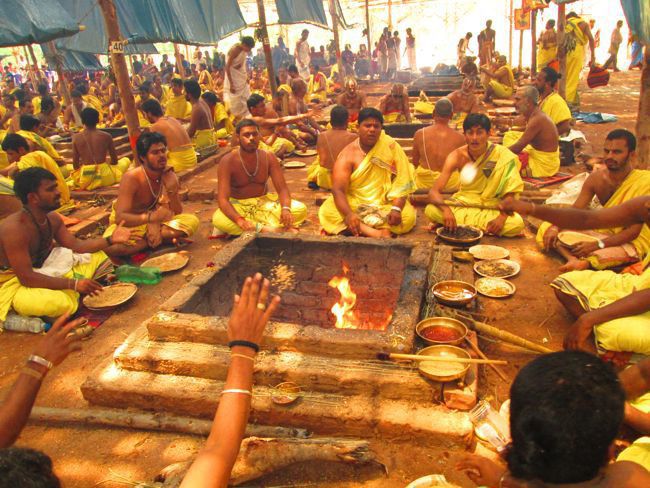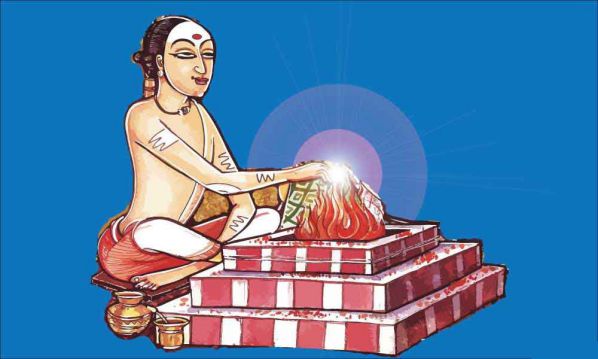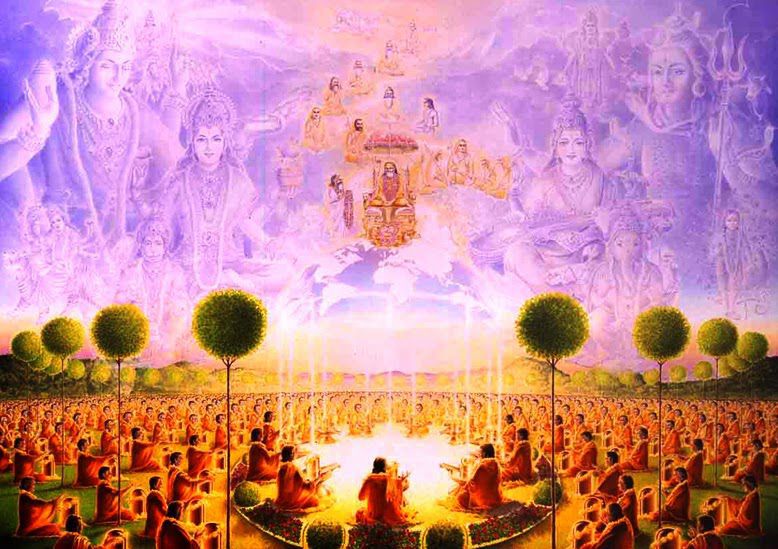No products in the cart.
Throughout time, fire has been venerated as a symbol of spirit. The first sloka in the Rig Veda is to Agni, to fire:
“Agni mide purohitam yagnasya devam ritvijam; hotaram ratna dhatamam”
“I offer my humble prayer to Agni, who is the Absolute Divine, the awakener of the inner energy and the giver of prosperity.”
In the ancient Vedic scriptures, Agni is the messenger between the people and God. Agni is equally the fire of the sun, of lightning and of the flame that humanity lights for purposes of worship. As the divine personification of the fire of sacrifice, Agni is the mouth of the gods, the carrier of the oblation and the messenger between the human and the divine. Sacred fire acts as a link between man’s consciousness and the cosmic consciousness. Sacred fire has the ability to convert the material offerings into psychic components, as offerings to the deities presiding over the yagnas.
Beginnings of Yagna
Yagnas are sacred rituals to invoke and propitiate various deities (energies) using fire as a revered medium for the attainment of various boons and general well-being. The sun (Surya) was the great luminary in the sky who gave light and warmth to the world and was the source of life on earth and its sustenance (Pushan). So people began to offer prayers to Surya in the morning and evening. At night they had to depend on fire (Agni) for heat and light. Gradually the link between Surya, the friend of all beings in the sky, and Agni, who lives among men on earth was established, conceived as different aspects of the one supreme self-luminous deity who also resides in all beings as the warmth of life and assimilates all food offerings poured into the jatharagni (fire in the stomach), which digests all food.
It was observed that the sun drew up the waters with its heat and the vapours rose to the sky to form clouds, returning as rain, and the earth produced vegetation – a circulation between the sky and the earth. It was also observed that when fire burned, the smoke rose to the sky, leaving only ashes, and water heated in vessels also rose to the sky as vapour. So the idea arose that material offerings to the deities in the sky could be made through fire. Fire also had its devata in Agni, and all these devatas were interconnected. If offerings are made to Agni, he would carry it to Surya and other deities in the sky.
With the performance of yagna changes are induced in the atmosphere, which evoke effects in the whole biosphere. Yagnas have been performed from ancient times to purify the natural environment and to secure timely rains so that the crops may be good and there may be prosperity, general well-being and happiness all around.
The Ritual of Yagna
 The Vedas are the original source of information about yagna. Vedic worship of fire is extremely detailed and complicated with many layers of symbol and meaning. Through rituals of purification, consecration and invocation, the entire yagnashala becomes the symbolic representation of the universe, with even the pillars worshipped as the energy that supports the universe. The demons, the negative aspects, also have a place in the divine creation, so they too are worshipped and offered food to their liking.
The Vedas are the original source of information about yagna. Vedic worship of fire is extremely detailed and complicated with many layers of symbol and meaning. Through rituals of purification, consecration and invocation, the entire yagnashala becomes the symbolic representation of the universe, with even the pillars worshipped as the energy that supports the universe. The demons, the negative aspects, also have a place in the divine creation, so they too are worshipped and offered food to their liking.
In these sacred rituals Agni, as fire, is created in the Kunda, the sacrificial fireplace, and various deities (energies) are invoked through chanting mantras from the Vedas and performing various hand gestures called mudras and nyasa. These actions have a subtle effect on the energy vibration, both internally and externally, enhancing the effect of the mantras. Mudras are performed at various stages, at the time of invocation and with specific offerings. There are different mudras relevant to each deity. The word mudra has several meanings: seal, imprint, mystery, code and gesture. The term nyasa is derived from the root nyas, which means ‘to place’. It refers to the placing of the fingers and palm of the hand on various parts of the body while chanting certain mantras. The purpose is to prepare the physical body for the reception, or awakening, of the divine presence of the deity.
The beginning of the ceremony is an invocation of surrender and light is offered to the divine. The lamp is waved in a series of Om patterns, balancing all aspects of nature and symbolizing the knowledge of God. A bell is rung, representing the inner sound, and the water offered represents the divine nectar of immortality. The sounding of the conch is Om, the primordial sound. Agni is invoked with the lighting of the physical fire. The wood (samidha or samit) is fed to the fire, representing qualities that are not necessary or appropriate. The fire is nourished by the ghee, which symbolizes mental clarity, abundance and spiritual wealth. The herbs offered represent the bliss released in all actions. The fire is made conscious with mantra and the offerings are made to the ishtah devata in the fire. Each of the mantras chanted is a name of God. The different aspects of God are called upon with reverence and offerings are made. Those attending a yagna will receive most benefit by keeping a silent, prayerful and respectful attitude, observing each thought, each picture, each emotion that comes to mind and offering that into the fire.
Ahuti or the Offerings
The act of offering is called ahuti or oblation. With each offering ‘Swaha’ (I offer) is said. Swaha is also the name of the wife of Agni. To honour his wife is to honour him in the highest way. All ritual offerings into the sacred fire are offered with this mantra; svah means ‘oneself’ and ha means ‘to offer’. The implication is the offering of oneself for the sake of others; the oblations are meant as substitutes for oneself. One is reborn through the act of sacrifice, the old being is burnt up and a new, divine being emerges, consecrated to altruism. Thus yagna is truly a transforming rite of passage ritual.
The worship of fire purifies the fire element in the body and also purifies the consciousness by amplifying the mantras. Our many senses and their objects are collectively offered in the fires of self-control (tapas, austerity) and purification. The senses are offered in the yoga of self-control, the higher meaning of yagna. The fire of yagna purifies negativity; thus ego, jealously, hatred, vices, ignorance, superstition and other ignoble aspects of the self are offered.
With the closing of the yagna, thanks are given for all of the many things that were sacrificed in order to make the sankalpa of the ritual. Mantras are chanted to ask forgiveness for any errors made. All are given blessings for their part in this most ancient ritual of worshipping the divine. At the end of the ceremony the light is presented to all and may be taken to fill the heart and mind. This is followed by silent prayer to guru and mother earth and the arati is joyfully sung to the lord of the universe.
There are many aspects to a yagna fire ritual. For example, the timing is important astrologically and the geometry is very important and exact. There are hundreds of little details in the preparations, the offerings, the decorations, and the performance, as well as the proper clean-up and handling of everything involved, including the ashes. As one surrenders to the beauty and holiness of yagna, the ‘ancientness’ and all-pervading quality of the element of fire becomes deeply moving.
The First Yagna – Sarvahut
The initial sacrifice was that of the divine being sacrificing himself to become the universe. The ancient Vedic hymn Purusha Sukta tells of the transformation of the eternal, infinite being into the finite cognizable material world, initiating the eternal cycle of creation. So the spirit of sacrifice came to be recognized as the source of creation, the heart of all creative forces.
This yagna was called sarvahut, the offering of all. The Purusha was the object of worship. Brahma, the creative aspect of the Purusha, performed it. The priests were the devas, the Purusha’s senses. Brahma was the beast of the sacrifice. The altar was all of nature. The fire was the Purusha’s heart. The Purusha himself was sacrificed to bring forth all of creation. This is a message of love, that the Purusha would consume himself in the fire of sacrifice, to create all the worlds. From his mind emerged the moon, the sun from his eyes, Indra and Agni from his mouth, and the cosmic breath, Vaayuh emerged from his breath (prana). Atmosphere emerged from his navel, the sphere of light (divyaloka) from his head, the earth from his feet, and the directions from his ears. The devas created all the spheres (lokas) from his cosmic body. Thus the gods worshipped the god of gods through sacrifice. The original sacrifice, the original yagna, became the law of life.
Perpetual Yagna
The world is God’s offering to all beings; it is his self-sacrifice to us. Therefore, our duty is to reciprocate by offering sacrifice to him in thanksgiving. The essential dynamic of the universe is that of a perpetual ritual of sacrifice. Every living entity is compelled to devour other forms of life in order to survive. The devoured is the sacrificial victim and the devourer is the sacrificer. This transformation of life into life is the very nature of existence. All creation’s beings perform yagna: the sun, moon and stars; the animals, fish, insects and birds; the trees, grasses and flowers, all are in a continual process of service and sacrifice. All existence can be reduced to a dichotomy of two factors; food (Annam) and the eater (annaadah). Every being is the eater of another and in turn becomes the food for some other being. This symbiotic relationship is particularly apparent in the fire, which grows immediately when fed with fuel and dies as soon as the fuel is consumed. All aspects of combustion or digestion are subtle forms of fire (vaishvanara Agni). We make our offerings to the fire-pit in our bellies; these offerings are transformed into the nutrients that fuel the organs, enabling them to serve the body so that it may carry on with the activities of life and honour the soul within. So life is a process of yagna – service and sacrifice, to achieve the ultimate yoga – union with the supreme consciousness.
Symbology in Yagna
Various symbols and actions are used to redirect our senses and heighten our sattvic emotions. The fire represents God or truth. The sacrificial food, the samagri (mixture of seeds, plants, resins, grains, etc.) is offered into the fire. The mixture represents our worldly samskaras such as attachment, greed, violence, etc. that bind us to our lower nature and trap us in egocentric thoughts and desires. We offer the seeds of all future actions into this fire of self-knowledge to be completely consumed. Symbolically we are offering our very lives into the fire of purification and sacrifice. While a specific number of people will actually offer the samagri, each of us can participate equally in the ritual by the degree of our sankalpa, awareness and surrender.
The offerings are substances that sustain life and always the best quality available is offered. Many of the items are natural antiseptics and aromatics. As they burn, the subsequent vapours pervade the atmosphere, destroying pollutants and purifying the environment for many kilometers around. The vibrations of the mantras enhance the beneficial effect of these vapours. This ritual not only benefits the external environment, the participants of yagna also benefit as purification takes place in each individual’s internal environment as the vapours and mantras permeate the physical, mental, emotional and spiritual entity.
The outer form of any ritual has an inner corresponding ritual. In yagna, Agni is the divine spark within the human being, the spirit or soul. The ghee or the clarified butter that is offered to Agni is symbolic of the mind. The Annam, the sacrificial food, symbolizes the physical body which is the transformed state of Annam. Once the divine spark of Agni is invoked, the latent energies or divine powers hidden within man awake to share the fruits of the sacrifice and assist the individual’s purification, transformation and spiritual awakening.
Yagna and Devatas
Yagnas link us with the devatas, the hidden cosmic forces. According to the Rig Vedic mystics, a human being performs an action only through assistance from the devas. The contribution of the human to each action is minimal. The great Vedic rishis obtained inspiration from superior planes and their main contribution is in transcribing the revealed verses in appropriate meters or rhythms. Yagna is not a mere rule or ritual, it is any activity that recognizes the collaboration between the deva and the human. A rishi is conscious of the divine’s hand in the performance of all activities and conscious of the role of the deva, especially of Agni, so that they request him to perform the yagna on their behalf.
The deities are not only forces of nature, but also forces or energies that exist in the physical body and help the individual’s spiritual development. Through yagna we contact the deities within. We prepare for this worship by bathing and wearing clean clothes. The mantras induce waves of energy in the subtle body that purify the subtle elements of the body, mind and environment, there by awakening the latent divine energies. With the help of sounds, forms, rhythms, gestures, flowers, light, incense and offerings, the mind is carried away from its material preoccupations toward a world of divine beauty.
The Ritual Priests
Every rite has four main priests: hotri, adhvaryu, udgatri and Brahman. The hotri chants the hymns of the Rig Veda, calling the devas to come and participate. The adhvaryu chants the hymns of the Yajur Veda, laying down the various steps of performance. The udgatri chants the Sama Veda hymns in the appropriate metres at specific times. The Brahman is the supervisor of the ceremony and chants the hymns of the Atharva Veda. The adhvaryu priest is the one who measures the sacrificial ground; builds all that is necessary; prepares the materials and kindles the fire. The success of the yagna is dependent on having the right set-up before the chanting and offering begins.
Types of Yagna
It is said that there are 1008 different yagnas with many kinds of offerings. Dravya yagna relates to the offering of physical, material objects. Tapo yagna is the offering of psychological processes. And yoga itself is turned into sacrifice. The principle of yoga is to sublimate the lower activities to the higher aims. The Bhagavad Gita points out that sacrifice of knowledge is the highest offering. One does not rest in knowledge; one offers the knowledge to the source of knowledge, which is why Lord Krishna says: “All action culminates in the highest knowledge.” The idea is to convert every output of the energy of life on every level, physical, vital, mental and spiritual, into offerings to the divine. So one who performs yagna with awareness undergoes a process of purification.
Yagnas which are offered by those who expect no reward and believe firmly that it is their duty to offer the sacrifice are considered sattvic. Those offered in expectation of reward or for the sake of ego are classed as rajasic. Those in which food is not distributed, mantras are not properly chanted, gifts are not given and which lack faith are tamasic. According to the Bhagavad Gita the word yagna is not confined to the lighting of the sacrificial fire and making offerings of samagri. Many other forms of yagna are mentioned in the Gita:
Some yogis, who are devoted to karma yoga, offer their actions to the gods; while others, who are devoted to Jnana yoga, and who have realized the Self, offer the Self in the fire of Brahman, just as one offers samagri to the sacred fire. (4.25)
Some again offer their ears and other sense organs into the fire of restraint, thus bringing their senses under control; others offer sound and other objects of perception into the fires of the senses. (4.26)
Others offer the functions of the senses and those of the breath (vital energy) in the fire of the yoga of self-restraint kindled by knowledge. (4.27)
Some offer their wealth for the welfare of the needy; some offer their austerities as sacrifice; some practice the eight limbs of raja yoga and offer this yoga (equanimity) as sacrifice; while others observe austere vows and offer study of the scriptures and knowledge as sacrifice. Thus sacrificial duties take many forms. (4.28)
The spirit of yagna is love, sacrifice and service. Yagna is a gift from the creator and a way to honour the creator. It is a symbol of life and all the processes of life. It is a symbol of creation and a method to honor creation. It is the esoteric science of life. The true meaning, value and spirit of yagna is the unity of God and humanity. This is what our life is all about – unity with the divine.
Yajnas are generally of three types-
Domestic Yajnas
The domestic yajnas are divided into two types-
Nitya Yajna or regular type of Yajnas
These are the everyday yajnas done by the people in a house. These Yajnas do not require the presence of a priest and the people can do it themselves as they are easier to perform.
There are five types of Yajna that are performed daily-
- Deva Yajna-
Deva Yajna is performed as an offering to the gods. These offerings are made for various reasons. It performed to atone for our sins that we commit unknowingly like causing the death of various creatures- ants, insects and microorganisms while walking or sitting. It is also performed to express our thanks to the deities that preside in our body (angirasas) and protect our organs and look after the body when we are asleep. It is our way of thanking them for keeping our body healthy and capable of doing work. In this firewood was burnt as a form of offering to the gods.
- Pitru Yajna-
Pitru Yajna is performed to provide offerings to our ancestors. It is performed to please those who are dead and to honour them. This Yajna is also performed after the death of our parents to thank them for giving us birth and taking care of us as we grew up. This Yajna is also performed to atone for our sins when we break a branch or a leaf or a flower.
- Bhoota Yajna-
In this Yajna offerings are made to other creatures like animals and insects. While moving around, sweeping the floor, washing things, sitting etc, many small creatures lose their lives unknowingly. Hence in Bhoota Yajna offerings are made to other creatures in other to atone for the sins caused by killing. For example, Rishis and saints had deers, cows and goats with them, and they made offerings to these creatures to express their love for them. Many people today scatter sugar for the ants and food for the birds. Some others have pets like dogs and cats in their house and they take care of them.
- Manushya Yajna-
Manushya yajna is performed as an offering to other human beings. This Yajna is performed to atone for the actions or the sins that we commit against other human beings (knowingly or unknowingly) in our day to day life. Charity and alms were usually given to the people in need.
- Brahma Yajna-
The ancient Sages considered human birth as precious and hence they laid down a set of principles and rules to guide the human beings and bring them on the right path. They laid down the four Purusharthas- Dharma, Artha, Kama and Moksha- as guidelines for humanity. These were only applicable for the humans and not for the birds and animals. This is because only the humans had intelligence and the sense to choose between right and wrong. Hence, the Brahma Yajna is performed as an offering to the Brahmans and rishis. It’s a way of thanking them for providing us the right way to lead life.
Naimittik Yajnas or occasional type of Yajnas
These Yajnas are performed occasionally by a household and has specific purposes. They are done for the fulfilment of a certain wish. These Yajnas require the presence of a priest and it cannot be done by the household themselves.
The following are the different types of Naimittik Yajna-
- Asvamedha:
Asvamedha Yajna was performed by a king to increase his dominance over other kingdoms. In this a horse was chosen and sprinkled with holy water. The priests recited some Mantras in the horse’s ears and it was them set free with an army protecting it. Each time the horse entered another kingdom, that kingdom had to surrender or fight the army accompanying the horse.
- Garbhadhana:
The Garbhadhana Yajna is performed before the act of having sex with the intention of impregnation. This Yajna is performed to increase the chances of the woman getting pregnant before the actual act is performed.
- Pumsayam:
The Pumsayam ritual was performed in order to ensure that the child carried by the mother in her womb was a boy. This Yajna increased the chances of the child being a boy. Boys were considered more important than girls because they represented the next generation of the house and were considered the inheritor of all the money and materials.
- Semontonnayam:
Semontonnayam yajna is performed when the woman of a house is pregnant. This Yajna is performed in order to ensure that the baby remains safe in the womb and is born without difficulties or problems.
- Jatkarma:
The Jatkarma Yajna is a ceremony performed before the cutting of the umbilical cord. In this ceremony the father touches the baby’s lips with ghee and honey. This ceremony is performed to ensure a good and long life for the infant.
- Culakarma:
Culakarma is a ceremony performed for the boy when they reach their third year. It is also known as Tonsure. In this ceremony the hair of the boy is cut completely and the boy becomes bald. This hair is then offered to the god for religious purposes.
Public Yajnas (Shrauta)
These Yajnas or rituals are performed in public and require the presence of more than one priest. The objects required for this Yajna are – wood sticks to be used as kindling to start the fire by friction, the spoon that will act as a vessel for offering the sacrifice to the Agni, the pressing stones of Soma stalks, a sacrificial vessel holding Soma and food offerings. The enclosure within which the ceremony took place contained a fire pit with the fire (Agni) to burn the offerings. The inside of the enclosure was covered with holy grass on which water was sprinkled according to the guidelines. Before putting the sacrifice into the fire, it was patronized by the priests. The sacrifice usually consisted of food and nourishments like- milk, fruit, vegetables, flowers, cereal, butter, powders etc. These Yajnas last for a long time and are generally done for wish fulfilment or for the betterment of the people in the community.








